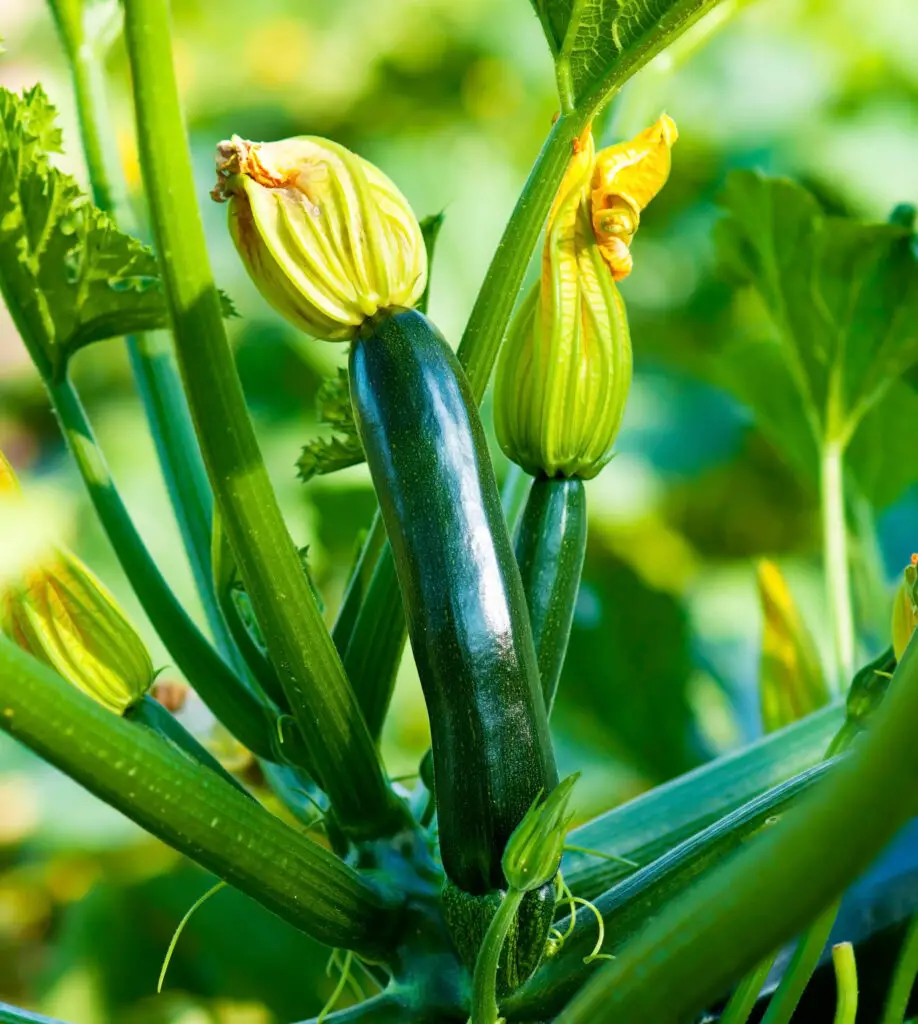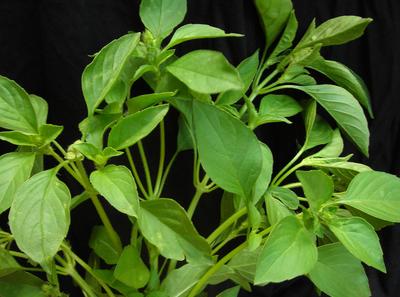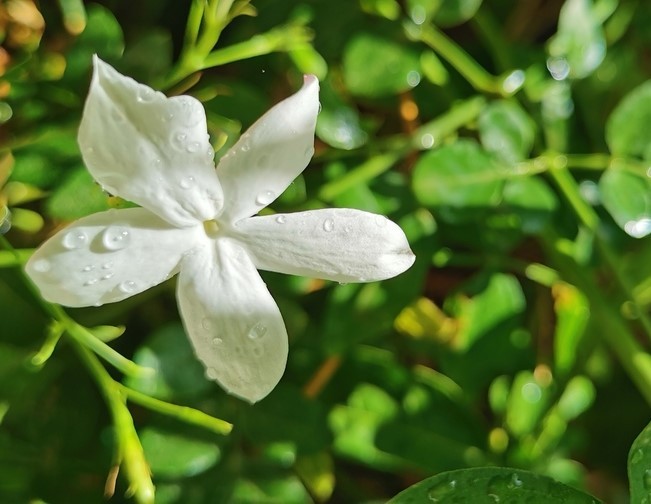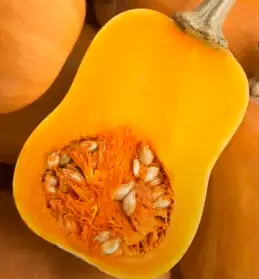If you’re wondering which red flowers would make your garden, balcony, or home look most beautiful, this article got you. I will introduce to you all you need to know about the most popular and most beautiful red flowers you can easily grow and enjoy.
Annual Red Flowers to Grow This Year
Red Impatiens
Impatiens, also known as “busy Lizzies“, are a popular genus of flowering plants in the family Balsaminaceae. They are known for their brightly colored, teardrop-shaped flowers that come in a wide range of colors, including red.
Some popular red impatiens varieties include ‘Super Elfin Red’ and ‘Elixir Red.’ Impatiens are shade-loving plants, making them a great choice for shady gardens or for planting under trees or on the north side of buildings.
Red impatiens are also popular for indoor container gardening. They grow best in cool and moist conditions and typically bloom from spring to fall. They are easy to care for, making them a great choice for both experienced and novice gardeners.
| Light | Red impatiens like partial to full shade. |
| Soil | Well-draining, moist, and rich soil. |
| Watering | Keep the soil moist, but not overwatered. |
| Fertilizer | Fertilize every 2-3 weeks. |
| Pruning | Prune when the stems reach about 8 inches tall. |
| Diseases/ Pests | Powdery mildew, leaf spot, downy mildew. |
| Temperature | Between 60 and 75°F (15 and 24°C) |
| Overwintering | They should be removed after the first frost in the fall. |
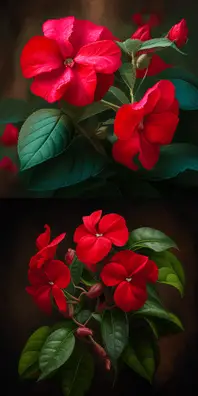
Red Poppies
Poppies are a popular genus of flowering plants in the family of Papaveraceae. One of the most well-known species is the red poppy, Papaver rhoeas, which is also known as the “corn poppy” or “Flanders poppy.”
They are often seen growing in wildflowers meadows and along roadsides. They are easy to grow and care for. They typically bloom in late spring to early summer. They will self-seed and can come back year after year.
| Light | Full sun. |
| Soil | Well-draining soil. |
| Watering | Water regularly (moist soil not waterlogged) |
| Fertilizer | Don’t require fertilizer but can be added. |
| Pruning | Prune the dead flowers to encourage new growth. |
| Temperature | can survive temperatures as low as -40°F (-40°C) and as high as 100°F (38°C). |
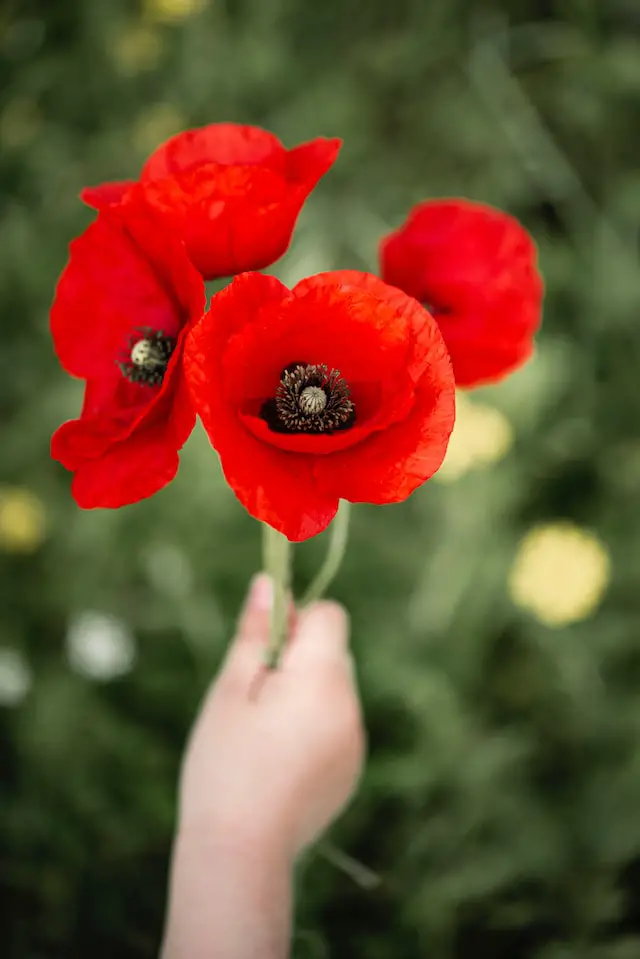
Red Salvia
Salvia is a large genus of flowering plants in the family Lamiaceae, also known as sage. There are many species and cultivars that come in a variety of colors, including red. Some popular red salvia varieties include Salvia splendens, also known as “Scarlet Sage” and Salvia coccinea, also known as “Crimson Sage” or “Summer Jewel Red”.
These plants are known for their showy, colorful flowers and are often used as bedding plants, in borders, or as container plants. They are also popular for their ability to attract hummingbirds and butterflies.
They typically bloom in late spring to summer and are easy to care for, making them a great choice for both experienced and novice gardeners.
| Light | Full sun to partial shade. |
| Soil | Well-draining soil. |
| Watering | Drought-tolerant. Prefer to water at the base of the plant to avoid fungal diseases. |
| Fertilizer | Every 4-6 weeks, use a balanced fertilizer. |
| Pruning | Trim each now and then to promote thicker growth. |
| Temperature | Between 60°F to 95°F (15°C to 35°C) |
| Overwintering | Can survive a light frost. |
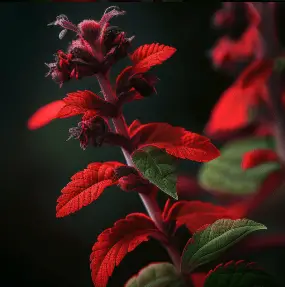
Read more: Why Are Hibiscus Flower Buds Dropping- Reasons & Treatment
Red Zinnias
Zinnias are a popular genus of flowering plants in the family Asteraceae. They are known for their brightly colored, daisy-like flowers that come in a wide range of colors, including red. Some popular red zinnia varieties include ‘Crimson King,’ ‘Carmen,’ and ‘Benary’s Giant Cherry.’
Zinnias are easy to grow and care for, making them a popular choice for both experienced and novice gardeners.
They are often used as bedding plants, in cutting gardens, or as container plants. They are also popular for their ability to attract pollinators such as butterflies and bees.
| Light | Full sun. |
| Soil | Well-draining soil. |
| Watering | Always keep the soil moist, not waterlogged. |
| Fertilizer | Use balanced, water-soluble fertilizer 2-3 times a week. |
| Diseases/ Pests | Powdery mildew, fungal diseases. |
| Temperature | Between 60-85 °F (16-29 °C). |
| Overwintering | Sensitive to frost. |
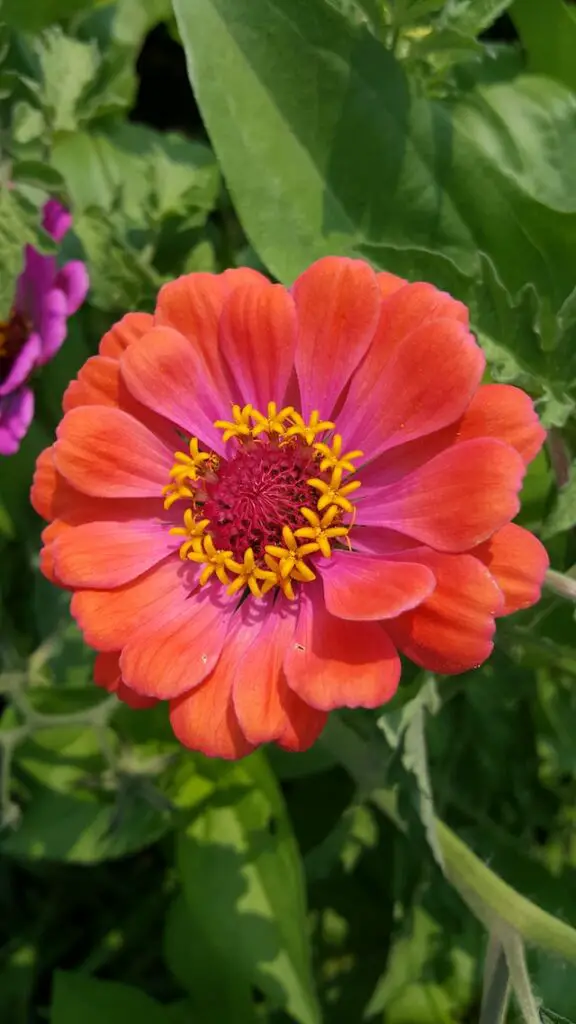
Red Marigolds
Marigolds are very known in the genus of flowering plants in the family Asteraceae. They are known for their brightly colored, daisy-like flowers that come in a variety of colors, including red.
Some popular red marigold varieties include ‘Moulin Rouge,’ ‘Fireball,’ and ‘Red Decora’. They are easy to grow and care for, making them a popular choice for both experienced and novice gardeners.
They typically bloom from late spring to fall. They are often used as bedding plants, in cutting gardens, or as container plants. They are also popular for their ability to deter pests and attract beneficial insects.
| Light | Full sun. |
| Soil | Well-draining soil. |
| Watering | Water regularly. |
| Fertilizer | Use balanced, water-soluble fertilizer 2-3 times a week. |
| Pruning | Prune the tips to promote growth. |
| Diseases/ Pests | Not affected by pests. Susceptible to powdery mildew. |
| Temperature | Between 60-85°F (16-29°C) |
| Overwintering | Tolerates only light frost. |
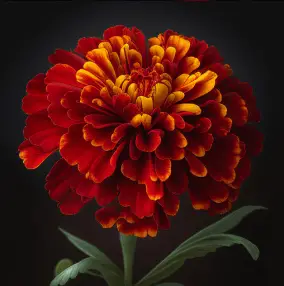
Read more: The Best Top 7 Smelling Jasmine Plants
Red Celosia
Celosia is a genus of flowering plants in the family Amaranthaceae. They are known for their brightly colored, feathery, or plumed flowers that come in a variety of colors, including red. Some popular red celosia varieties include ‘Dragon’s Breath,’ ‘Flamingo Feather,’ and ‘Cockscomb Red.’
They are often used as bedding plants, in borders, or as container plants. They are also popular for their ability to attract hummingbirds and butterflies. They bloom from summer to fall. They are very easy to care for, even for beginners.
Fun fact about red celosia flowers: They are known as “cockscomb” due to the shape of their inflorescence, which resembles the comb on the head of a rooster.
| Light | Full sun. |
| Soil | Well-draining soil. |
| Watering | Water regularly. |
| Fertilizer | Use balanced, water-soluble fertilizer 2-3 times a week. |
| Pruning | Remove dead blooms to promote more growth. |
| Diseases/ Pests | Not affected by pests. Susceptible to powdery mildew. |
| Temperature | Between 60-85°F (16-29°C). |
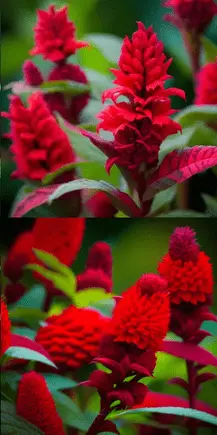
Red Gaillardia
Gaillardia, also known as blanket flowers, is a genus of plants in the sunflower family (Asteraceae). They are known for their brightly colored, daisy-like flowers.
Some popular red Gaillardia varieties include ‘Goblin,’ ‘Arizona Sun,’ and ‘Fanfare Red.’ These plants are native to North America and are popular for their ability to thrive in hot, dry conditions. They are often used as bedding plants, in cutting gardens, or as container plants.
Red Gaillardia flowers bloom from late spring to fall.
Fun fact about gaillardia flowers: They are known as a “blanket flower” because of their large, colorful blooms that resemble blankets.
| Light | Full sun. |
| Soil | Well-draining soil. |
| Watering | Drought tolerant but prefers to remain moist. |
| Fertilizer | Use balanced, water-soluble fertilizer 2-3 times a week. |
| Diseases/ Pests | Not affected by pests. Susceptible to powdery mildew. |
| Temperature | Between 60-85°F (16-29°C) |
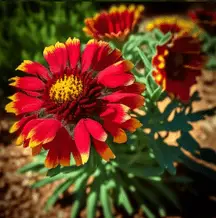
Read more: Causes of Ants on Orchid & How to Prevent & Get Rid of Them.
Red Nicotiana
Nicotiana is a genus of plants in the family Solanaceae, commonly known as tobacco plants. They are known for their trumpet-shaped, fragrant flowers that come in a variety of colors. Some popular red nicotiana varieties include ‘Red Riding Hood’ and ‘Perfume Deep Red’.
These plants are often grown as annuals and are popular for their ability to bloom all summer long. They are often used as bedding plants, in cutting gardens, or as container plants. They bloom from late spring to fall. The red varieties of Nicotiana are known for their intense red color and sweet fragrance.
| Light | Full sun to partial shade. |
| Soil | Well-draining soil. |
| Watering | Water regularly. |
| Fertilizer | Use balanced, water-soluble fertilizer 2-3 times a week. |
| Diseases/ Pests | Not affected by pests. Susceptible to powdery mildew. |
| Temperature | Between 60-70°F (16-21°C) |
| Overwintering | Can survive a light frost. |
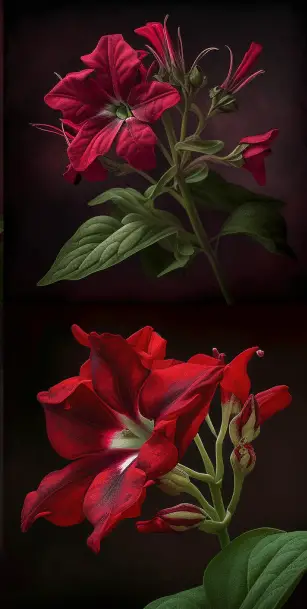
Red Petunias
Petunias are a popular genus of flowering plants in the family Solanaceae. They are known for their brightly colored, trumpet-shaped flowers that come in a variety of colors, including red.
Some popular red petunia varieties include ‘Fire Chief,’ ‘Crimson Star,’ and ‘Red Ruffles.’ These plants are often used in hanging baskets, as bedding plants, or in container gardens.
They are also popular for their ability to bloom all summer long and are known for being easy to care for. They are grown as annuals in most climates but can be perennials in tropical regions.
| Light | Full sun. |
| Soil | Well-draining soil. |
| Watering | Water regularly. |
| Fertilizer | Use balanced, water-soluble fertilizer 2-3 times a week. |
| Pruning | Prune dead flowers to promote more blooms. |
| Diseases/ Pests | Susceptible to powdery mildew. Can be affected by aphids, and thrips. |
| Temperature | Between 60-85°F (16-29°C) |
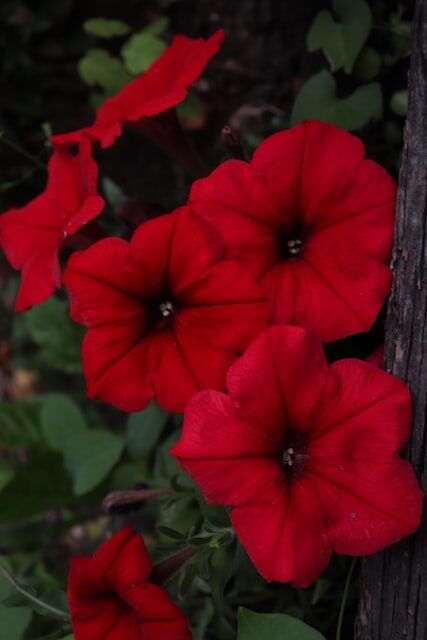
Red Verbena
Verbena is a genus of flowering plants in the family Verbenaceae. There are several species of verbena, and many of them come in different colors, including red.
These plants are often used as ornamental flowers in gardens and as groundcovers. They are known for their showy, colorful blooms and are often used in butterfly gardens and other pollinator-friendly landscapes.
| Light | Full sun. |
| Soil | Well-draining soil. |
| Watering | Water regularly. |
| Fertilizer | Use balanced, water-soluble fertilizer 2-3 times a week. |
| Pruning | Remove deadheads to encourage more flowering. |
| Diseases/ Pests | Not affected by pests. Susceptible to powdery mildew. |
| Temperature | Between 60-85°F (16-29°C) |
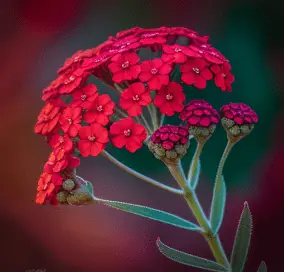
I hope this information was helpful and now you’re able to decide which red flowers you should get!
Please follow us on our social media platforms:
Disclaimer: Some of the above-used images are generated by AI ( Midjourney)

